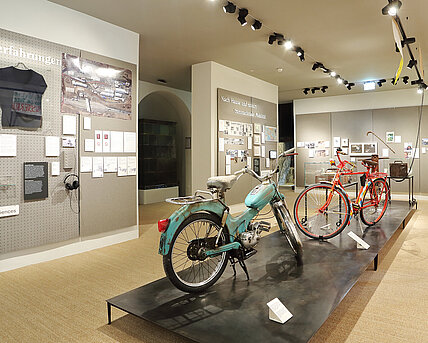Items from everyday life in the Folk Life Museum tell of social life, of human fates and needs through the ages. Living, dressing, and faith are three themes that play a key role in people’s daily lives, and also shape the permanent exhibition in the Folk Life Museum. On show are objects that tell us something about people’s wishes, needs and concepts of life in the pre-industrial age, predominately. In the museum’s original openfire kitchen, we can dip—with all our senses—into peasant life from centuries gone by.




















![Folk Life Museum at the Paulustor [Translate to English:] Ansicht Standort Volkskundemuseum](/fileadmin/_processed_/a/d/csm_Ansicht_Volkskundemuseum_2023_22_a5e9e4d9bd.jpg)

![Folk Life Museum at the Paulustor [Translate to English:] Ansicht Standort Volkskundemuseum](/fileadmin/_processed_/7/4/csm_Ansicht_Volkskundemuseum_2023_21_b88113905e.jpg)
![Folk Life Museum at the Paulustor [Translate to English:] Ansicht Standort Volkskundemuseum](/fileadmin/_processed_/a/d/csm_Ansicht_Volkskundemuseum_2023_22_a88a14f64c.jpg)
![Folk Life Museum at the Paulustor [Translate to English:] Ansicht Standort Volkskundemuseum](/fileadmin/_processed_/f/0/csm_Ansicht_Volkskundemuseum_2023_24_e578dc6fbb.jpg)
![Folk Life Museum at the Paulustor [Translate to English:] Ansicht Standort Volkskundemuseum](/fileadmin/_processed_/b/6/csm_Ansicht_Volkskundemuseum_2023_23_9b517378dd.jpg)
![Folk Life Museum at the Paulustor [Translate to English:] Ansicht Standort Volkskundemuseum](/fileadmin/_processed_/9/2/csm_Ansicht_Volkskundemuseum_2023_01_32a1379da9.jpg)
![Folk Life Museum at the Paulustor [Translate to English:] Ansicht Standort Volkskundemuseum](/fileadmin/_processed_/1/6/csm_Ansicht_Volkskundemuseum_2023_02_3ed59e5c33.jpg)
![Folk Life Museum at the Paulustor [Translate to English:] Ansicht Standort Volkskundemuseum](/fileadmin/_processed_/1/a/csm_Ansicht_Volkskundemuseum_2023_25_175333f16a.jpg)
![Folk Life Museum at the Paulustor [Translate to English:] Ansicht Standort Volkskundemuseum](/fileadmin/_processed_/7/c/csm_Ansicht_Volkskundemuseum_2023_29_3c6dc762ce.jpg)
![Folk Life Museum at the Paulustor [Translate to English:] Ansicht Standort Volkskundemuseum](/fileadmin/_processed_/1/b/csm_Ansicht_Volkskundemuseum_2023_32_74cce4e05e.jpg)
![Folk Life Museum at the Paulustor [Translate to English:] Ansicht Standort Volkskundemuseum](/fileadmin/_processed_/1/7/csm_Ansicht_Volkskundemuseum_2023_35_4c588fe7f4.jpg)
![Folk Life Museum at the Paulustor [Translate to English:] Ansicht Standort Volkskundemuseum](/fileadmin/_processed_/d/a/csm_Ansicht_Volkskundemuseum_2023_36_a8d6701317.jpg)
![Folk Life Museum at the Paulustor [Translate to English:] Ansicht Standort Volkskundemuseum](/fileadmin/_processed_/7/a/csm_Ansicht_Volkskundemuseum_2023_37_71bb73f10b.jpg)
![Folk Life Museum at the Paulustor [Translate to English:] Ansicht Standort Volkskundemuseum](/fileadmin/_processed_/d/c/csm_Ansicht_Volkskundemuseum_2023_38_fa09e89dad.jpg)
![Folk Life Museum at the Paulustor [Translate to English:] Ansicht Standort Volkskundemuseum](/fileadmin/_processed_/1/2/csm_Ansicht_Volkskundemuseum_2023_41_aea52b92d6.jpg)
![Folk Life Museum at the Paulustor [Translate to English:] Ansicht Standort Volkskundemuseum](/fileadmin/_processed_/c/0/csm_Ansicht_Volkskundemuseum_2023_39_b38aae5664.jpg)

![Folk Life Museum at the Paulustor, the church of St Anthony of Padua [Translate to English:] Ansicht Standort Volkskundemuseum](/fileadmin/_processed_/b/2/csm_Ansicht_Volkskundemuseum_2023_04_14e5e63854.jpg)